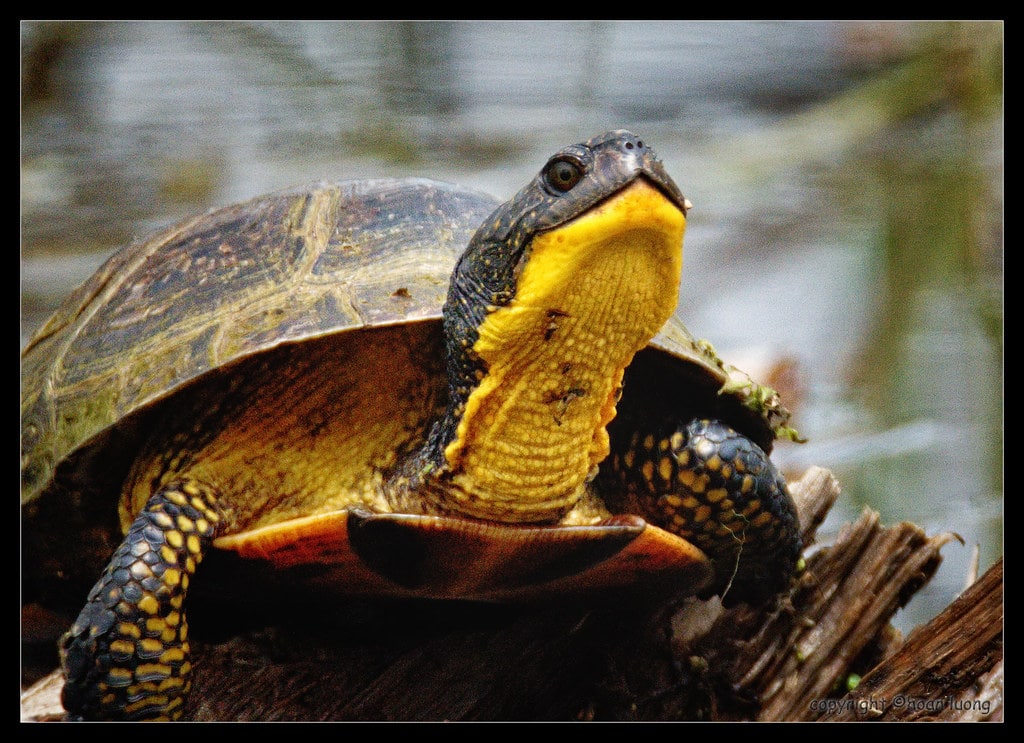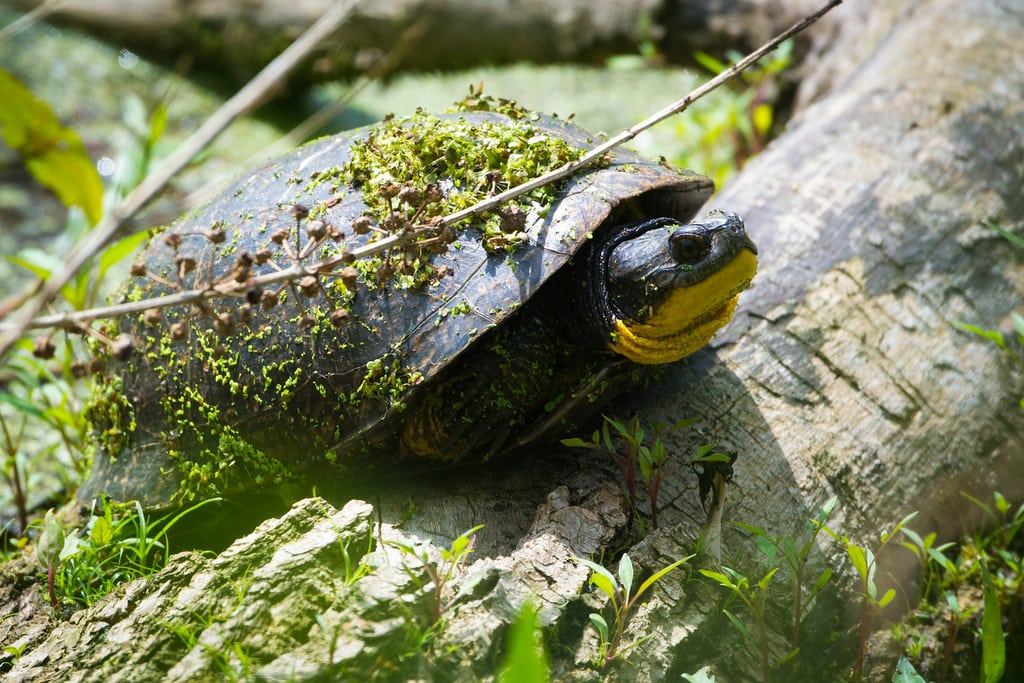
We don’t really know exactly how long the Blanding’s Turtle has been here. We do know that turtles are thought to be one of the oldest currently living reptile groups, in some cases with turtle fossil records that go back over 200 million years! No wonder the turtle plays such an important role in Indigenous cultures all over the world.
In our North American written history, this particular turtle was first mentioned in 1833 by an American Naturalist, Dr. William Blanding. Today, people sometimes mistake the Blanding’s Turtle for a Painted Turtle, and while they do have some similarities, the Blanding’s Turtle is one everyone should take notice of.
While the Painted Turtle seems to be doing a great job of surviving in our world, the Blanding Turtle is having a harder time.
The Blanding’s Turtle with its dark coloured, high carapace (that’s what their shell is called) and yellow or cream coloured underside (which is called a plastron) is a Species at Risk here in the Frontenac Arch Biosphere.
It loves to make its home in shallow wetlands, marshes, or ponds that have muddy, soft bottoms. If you go hiking in the FAB region, you can expect to see Blanding’s Turtles sunning themselves on rocks or logs. Just about any provincial park or lake in the FAB region could be a suitable home for the Blanding’s Turtle, but, also keep your eyes peeled when on farms that have natural wetlands. On the right farm, this turtle can live a very safe and long life, without the risk of road mortality.

Like many turtles, Blanding’s have predators, but it’s not predators that are pushing this turtle further towards extinction. It’s habitat loss and road fatalities that are making it harder and harder for the turtle to reach breeding age.
While a Painted Turtle can start breeding and laying eggs as early as age 4, the Blanding’s Turtle needs to be between 14 and 20 years old. As their natural habitats shrink, and they are more and more at risk of death crossing busy roads, the future is not looking great for this turtle. Unlike the Snapping Turtle that lays large clutches of eggs, the Blanding’s Turtle only lays about 8 eggs per year.
As their populations begin to decline, it is difficult for them to recover because it takes so long for them to reproduce, and the small nest sizes. If they can manage to avoid predation or death on a roadway, they can often live to be about 80 years or older.
Blanding’s turtles are important in our ecosystem because they help control populations of insects, snails, and small fish. Their snacking on pond vegetation helps maintain a healthy balance in freshwater habitats.
Blanding’s turtles are also important for nutrient cycling. They help recycle nutrients by consuming dead plant and animal matter, and their waste products contribute to the nutrient content of their habitats.
Blanding’s turtles are what is called an indicator species. Their presence or absence can provide us valuable information about the health of an ecosystem.
Blanding’s turtles are culturally significant to many Indigenous peoples and local communities in the FAB region. Turtles have been an important part of the ecosystem for thousands of years and are often considered a symbol of longevity and wisdom. Protecting Blanding’s turtles and their habitats can help preserve this cultural heritage for future generations.
So how can you help protect the Blanding’s Turtle?
Due to their Species at Risk Status, it’s important that one be cautious and respectful when you encounter them in nature.
The Ontario Ministry of the Environment, Conservation, and Parks gives us the following guidelines to help this special turtle species:
Report a Sighting
- The Ministry of Natural Resources and Forestry tracks species at risk such as the Blanding’s Turtle. The Ontario Reptile and Amphibian Atlas also collects observations of all Ontario reptiles and amphibians. Submit your observations at: www.ontarionature.org/atlas
- Photographs with specific locations or mapping coordinates are always helpful.
Volunteer
- Volunteer with your local nature club or provincial park to participate in surveys or stewardship work focused on species at risk.
Be a good steward
- Private landowners have a very important role to play in species recovery. If you find Blanding’s Turtle on your land, you may be eligible for stewardship programs that support the protection and recovery of species at risk and their habitats.
- As with many other rare plants and animals, the Blanding’s Turtle is at risk due to the loss of wetland habitat. You can help by protecting any wetlands and surrounding natural vegetation on your property.
- For farmers that have wetlands on their property, it’s important to fence riparian areas off from livestock. There are grants available to help with these costs.
- Every year, turtles all over the province must cross busy roads to get to their nesting sites. Female Blanding’s Turtles sometimes mistake gravel shoulders of roads as good nesting sites! Watch for turtles on the roads, especially between May and October.
- Never buy native species of turtles or any turtles that have been caught in the wild. If you see native species of turtles for sale in a pet store or food market, please contact the Ministry of Natural Resources and Forestry.
- Visit the Toronto Zoo Adopt-a-Pond website to learn more about Ontario’s rare turtles, their habitat and related conservation initiatives.
Report illegal activity
- Report any illegal activity related to plants and wildlife to 1-877-TIPS-MNR (847-7667).
Quick stats:
Scientific name: Emydoidea blandingii
Status: Species at Risk, Threatened
Description: medium-sized turtle with a bright yellow throat and chin. Unlike many Ontario turtles that have wide, flatter shells, the Blanding’s Turtle has a domed shell that resembles an army helmet. The shell is black to brown with yellow flecks and streaks and can reach 27cm long. Its head and limbs are black-grey and the bottom shell is rich yellow.
Habitat: Shallow water, usually in large wetlands and shallow lakes with lots of water plants.
Location: Blanding’s Turtles can be found throughout southern, central and eastern Ontario, in and around the Great Lakes Basin, with isolated populations elsewhere in the United States and Canada. In Canada, we separate the Blanding’s Turtle into the Great Lakes-St. Lawrence population and the Nova Scotia population.
Another turtle in the FAB region that you should learn about is the Snapping Turtle. It is also on the Species at Risk list, and an important part of our ecosystem. Check out our blog post about it to learn more. Snapping Turtle





